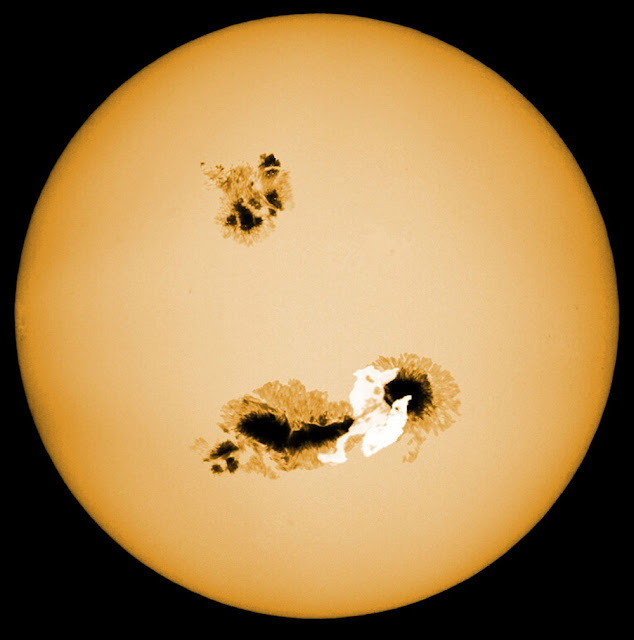Stars that are just like our Sun have flares more than a million times more energetic than the biggest flare ever seen on the Sun. The Kepler satellite has allowed these superflares to be studied in detail for the first time.
A superflare on a Sun-like star is a brightening that has an energy of from 1033 to more than 1039 erg and lasts from minutes to days. The Sun has frequent flares that are caused by magnetic effects above sunspots, regions that are cooler than the Sun's typical surface temperature. However, the largest flare ever observed on the Sun ― the 1859 Carrington event ― had a total energy of about 1032 erg. With Sun-like stars being the epitome of constancy, it is startling, evocative and exciting that they can have superflares as energetic as 1039 erg. In a paper published on Nature's website, Maehara et al. report the emissions from 365 superflares, measured by the awesome Kepler satellite, which was launched in 2009.
Maehara and colleagues analyzed data from the Kepler satellite, which provides continuous monitoring of the brightness of more than 100,000 stars for years on end with an accuracy of 10 parts per million. The authors have looked at some 83,000 G-type main-sequence stars and provide light curves ― plots showing the evolution of an object's brightness over time ― for 365 superflares on 148 stars.
The Kepler superflares have durations of 1–12 hours, brightness increases of 0.1–30% and total energies of 1033-1036 erg. A typical star in the Kepler data set has 1035 erg flares every 100 days. Interestingly, Maehara et al. find that the observed superflares all occur on stars that have large starspots, as evidenced by quasi-periodic modulation of the star's quiescent brightness. This finding crucially ties the superflares to starspots and hence to magnetic fields. Another insight is that the superflare stars apparently have no planetary transits ― that is, no planets have been found to pass in front them. However, roughly 10% of the superflare stars should have such transits if they are all associated with hot Jupiters. So the mechanism underlying superflares remains unclear.
The possibility that the Sun has superflares is not realized. Historical and geophysical records show that the Sun has not had any superflares in the past two millennia, and no superflares with more than roughly 1036 erg for perhaps a billion years. Maehara et al. show that only 0.2% of Sun-like stars have superflares, so it is unlikely that the Sun has such events. With their average rate of occurrence and their observed size distribution, the expected frequency of 1032 erg flares on all superflare stars should be very high. In stark contrast to this, the Sun has one 1032 erg event roughly every 450 years, and so is completely different from superflare stars. This is all readily understood within the default model, because the Sun does not have a hot Jupiter.
Superflares have implications far beyond being just a challenge for stellar physics. If a superflare's energy is linked to the orbital energy of a hot Jupiter, then three events a year on the star would make its planetary companion spiral in towards it on a timescale of a billion years. The huge energy output of superflares could make any planets around the star uninhabitable for far-future human colonization, and astrobiologists will have to consider the effect of the superflares on possible alien life. Superflares might provide the high-energy radiation required to create organic molecules, so perhaps superflare systems are a good place to look for alien life that has evolved to avoid the effects of the huge flares.
Here below is the abstract from the paper by Maehara and colleagues published online on May 16, 2012:
Solar flares are caused by the sudden release of magnetic energy stored near sunspots. They release 1029 to 1032 ergs of energy on a timescale of hours. Similar flares have been observed on many stars, with larger ‘superflares’ seen on a variety of stars, some of which are rapidly rotating and some of which are of ordinary solar type. The small number of superflares observed on solar-type stars has hitherto precluded a detailed study of them. Here we report observations of 365 superflares, including some from slowly rotating solar-type stars, from about 83,000 stars observed over 120 days. Quasi-periodic brightness modulations observed in the solar-type stars suggest that they have much larger starspots than does the Sun. The maximum energy of the flare is not correlated with the stellar rotation period, but the data suggest that superflares occur more frequently on rapidly rotating stars. It has been proposed that hot Jupiters may be important in the generation of superflares on solar-type stars, but none have been discovered around the stars that we have studied, indicating that hot Jupiters associated with superflares are rare.
Sources:
- Bradley E. Schaefer, Astrophysics: Startling superflares, Nature, 16 May 2012
- Hiroyuki Maehara et al., Superflares on solar-type stars, Nature, 16 May 2012
- Maggie McKee, 'Superflares' erupt on some Sun-like stars, Nature, 16 May 2012


